My Favorite Westerns
I will be the first to admit that there are plenty of westerns I have never seen (good, bad or indifferent). I'm sure there are several reasons why, but I'm only going to express to you the most obvious one. I've grown extremely accustomed to the “action western.” If there wasn't some sort of “white hat-wearing" gun-slinger there to exact justice, I felt that it really wasn't worth my attention.
Between the ages of twelve and sixteen, my father had introduced to me two movies that helped shape what I felt were then, as well are still today, the quintessential films of the western genre. Both are located in the number one and number two slots and have become a measuring standard of everything else I've seen since then.
As my palette matured, so did my opinion of westerns. I started to appreciate not only the “action western” but films that took place in the American West that contained multi-layered characters or films that were not only driven by action. I also started to recognize and admire films that were entirely different, or at least skewed from the mainstream of your sterotypical Hollywood western.
Here are my Top Ten Favorite Westerns:
10. THE OUTLAW JOSEY WALES

Year Released: 1976
Director: Clint Eastwood
By the time I first saw The Outlaw Josey Wales, I had already started down the road to my fascination with Clint Eastwood. But once I grabbed his biography off of a book store bargain rack, I was hooked.
In Outlaw, Clint Eastwood portrays the title character, Josey Wales, a farmer in Missouri who joins an outlaw confederate guerrilla unit after his family is slaughtered by the Union Army. Josey's main objective is vengeance; to hunt down those who destroyed his life. Throughout the film he comes in contact with quite an assortment of characters who end up joining him on his journey, with or without his consent. By the end, the pages turn, and he ends up being pursued by the group who incidentally killed his family in the first place, which leads to a rather satisfying climax.
My View: The Outlaw Josey Wales is one of Clint Eastwood's best directorial efforts. Unlike the "Man With No Name", Eastwood provides the audience with a great deal of sympathy for Josey, and in doing so, he makes the character much easier for everyone to identify with. The film is beautifully weaved with witty and humorous dialog, (not always a common factor in most of Eastwood's westerns), where Lone Waite, played brilliantly by Chief Dan George, steals almost every scene opposite Clint Eastwood.
Best Line:
Josey Wales: "When I get to likin' someone, they ain't around long."
Lone Watie: "I notice when you get to dislikin' someone they ain't around for long neither."
9. OPEN RANGE
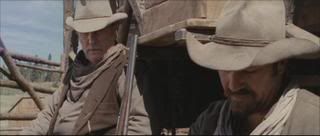
Year Released: 2003
Director: Kevin Costner
At one point in time, Kevin Costner could do no wrong. Then, in 1995, Waterworld was released, and American moviegoers weren't sure if what they had been investing in for the past ten years was still paying off. Suddenly, Costner wasn't a guaranteed bankable blockbuster star, at least for the studios. Since then, his films have been hit-and-miss. Then along came Open Range.
Costner, while battling pneumonia and later a burst appendix throughout production, was still able to bring to the screen what most audiences felt was dead: Another Great American Western. The film takes place during a post-Civil War America, where the great frontier is quickly losing its majestic presence, while ranchers and entrepreneurs buy up as much land as they can get their hands on. Boss Spearman (Robert Duvall) and Charley Waite (Costner) portray two cattlemen who run into more trouble than what either desires, when they're bullied by a rancher and his "hired guns" who despise their "free grazing" philosophy.
My View: Costner successfully brings to life an American West that most viewers have never seen before: the potential evils of entrepreneurship and how the haunting past of a violent and bloody civil war effected certain individuals. The pacing is a bit slow, but it never takes away from the simple, yet complex story of redemption. Costner should also be credited for portraying one of the most realistic gun fights ever filmed.
Best Line:
Boss Spearman: "My friend and me got a hankerin' for Switzerland chocolate and a good smoke."
8. ONCE UPON A TIME IN THE WEST
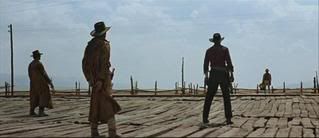
Year Released: 1968
Director: Sergio Leone
There are certain films that get better the more times they're viewed. Once Upon A Time In The West not only can be catagorized as that, but it can honestly lead the pack. I don't normally recommend it to most moviegoers; at least not at first. It's extremely hard to comprehend its cinematic brilliance on its first viewing. Instead, you're probably drawn more to your watch, realizing how unbelievably slow this movie is!
Are there pacing issues throughout this film? Absolutely (or at least to the novice popcorn muncher). However, for the more seasoned film connoisseur, you will be utterly transfixed on Sergio Leone's ability to turn a blank canvas into a beautifully-framed piece of artwork with a film camera. The story is rather simple: a mysterious harmonica player (Charles Bronson) joins forces with a desperado (Jason Robards) to protect a widow and her land from a hired gun (Henry Fonda) working for the railroad.
My View: Most critics say that if Eastwood would have signed on to do one more film with Leone, Once Upon A Time In The West would have ended up becoming their best collaboration. I think I would have to agree. The film definately stands up on its own merits, but Bronson is no Eastwood. Henry Fonda, however, perfectly demonstrates his acting chops. Normally seen as an "every man's hero", Fonda plays Frank with so much ruthlessness, that it's almost impossible to comprehend this sociopathic killer.
Best Line:
Frank: "How can you trust a man who wears both a belt and suspenders? The man can't even trust his own pants."
7. BUTCH CASSIDY AND THE SUNDANCE KID

Year Released: 1969
Director: George Roy Hill
This was the western that introduced me to a much larger variation on not only what a western was, but what it also could be. Butch Cassidy and the Sundance Kid starred Paul Newman and Robert Redford as the two historical characters whose mis-adventures were just as evident as their accomplishments. After one too many train robberies, Butch and Sundance are pursued through what seems to be half the country. In a desperate attempt to escape their ever persistent posse, they jump off a cliff, eventually escaping to Bolivia. In Bolivia, they eventually succumb to their old habits, but with unfortunate consequences.
My View: The late sixties were plagued with other counterculture ultra-violent outlaw movies, like The Wild Bunch and Bonnie and Clyde. Butch Cassidy and the Sundance Kid brought and entirely new spin to more than one type of genre, by presenting the American public with a good-natured western where the film displayed slapstick humor, traditional western action and contemporary music all while poking fun at western film cliches.
Best Line:
Butch Cassidy: "What's the matter with you?"
Sundance Kid: "I can't swim."
Butch Cassidy: "Are you crazy? The fall will probably kill you."
6. DANCES WITH WOLVES
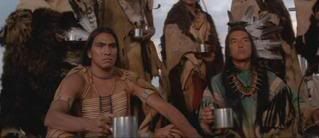
Year Released: 1990
Director: Kevin Costner
Dances With Wolves is probably the most non-traditional western on my list. Non-traditional in the sense compared to the stereotypical "black hat" wearing antagonist, "white hat" wearing protagonist Hollywood western. It was, however, the first time I had truly remember seeing a film where Native Americans were not portrayed as only blood-thirsty savages and killers.
Lieutenant John Dunbar (Kevin Costner), in an attempt to end his life rather than losing his leg, unintentionally causes a stagnent civil war battle to be won by the Union Army. In return for his valiant efforts, he's treated by his general's surgeon and awarded the position at any U.S. Army post in the country. Dunbar choses a post located on the unsettled western frontier. Unbeknownst to him, Fort Sedgwick has been abandoned by the Army. When he arrives, he encounters a deserted base who had recently been housed by apparent individuals who had gone mad. Dunbar, after a few months, comes in contact with a Native American tribe, The Sioux. He develops a wonderful relationship with the Sioux and eventually joins their tribe. He tells his entire story through the writing of his journal.
My View: Other than my atrocious summary of the four-hour movie (yes, the director's cut is that long), Dances With Wolves does not age with time. The themes presented throughout the picture are just as hard-hitting today as they were when the film was released eighteen years ago. It also goes to show you how much the film industry has changed over the that time span. This picture grossed over $180 million dollars, but it took over 50 weeks in order to do so. Can you imagine a pictures staying in the theater for almost a year straight? Not in this day and age.
Best Line:
[Dunbar has found an old skeleton on the prairie]
Timmons: "I'll bet someone back east is going, 'Now why don't he write?'"
5. LONESOME DOVE
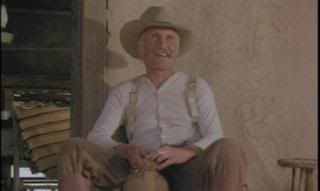
Year Released: 1989
Director: Simon Wincer
The only western listed here that was not an actual theatrically released film. Lonesome Dove was a mini-series that broadcast on CBS in 1989. This series presented to me a very story-driven western with wonderful multi-layered characters. The series didn't thrive on moving from gun battle to gun battle, but rather from brilliantly written and executed dialog.
Agustus "Gus" McCrae (Robert Duvall) and Woodrow F. Call (Tommy Lee Jones) are two ex-Texas Rangers who run a cattle ranch in Texas near the border of Mexico. The two decide to run a heard of cattle up north to Montana after a brief encounter with a former comrade shows up while on the run from killing a Mayor in Arkansas. The four episodes are beautifully weaved between several second-string characters played by Danny Glover, Robert Urich, Diane Lane, Fredrick Forrest, Rick Schroder, D.B. Sweeney, Anjelica Houson, Chris Cooper and Steve Buscemi among many others.
My View: I've never really even placed this mini-series in the same category as other television dramas. The sheer talent in the cast alone elevates it further than most mini-series from thirty years agos, let alone today. The producers hit the mark so high with this series, that all other sequels that followed couldn't even come close to this masterpiece.
Best Line:
Woodrow Call: "Well what does it say in Latin?"
[Gus blusters some gibberish]
Woodrow Call: "For all you know it invites people to rob us."
Gus McCrae: "Well the first man comes along that can read Latin is welcome to rob us, far as I'm concerned. I'd like a chance t' shoot at a educated man once in my life."
4. UNFORGIVEN
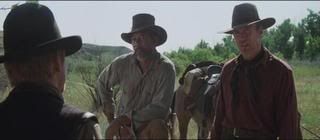
Year Released: 1992
Director: Clint Eastwood
I remember the first time I saw this film. I was sixteen and went to the movies with my girlfriend and her family. I had never seen anything like it before, and to be completely honest, didn't really care for it. It was slow and boring (pacing has always been an issue with me, with most Eastwood-directed pictures). But most importantly, I didn't understand at that age the kind of film that I was watching. It wasn't like the other Clint Eastwood westerns that I had grown up watching. Once I was in college, I had approached the film from an entirely new perspective.
Clint Eastwood plays Will Munny, a retired gunslinger and murderer, who changed his ways when he got married. He settled down, started a family, worked the family farm and eventually became a widower. He's approached by The Schofield Kid, a young and very senseless gunfighter who's heard of Munny's reputation. The Kid presents Munny with an offer to split a bounty of $1000 on killing two men wanted for cutting up and beating a prostitute in Wyoming. He at first declines, telling the Kid that his killing days are over. After reconsidering the offer, he joins the Schofield Kid along with his former partner, Ned Logan (Morgan Freeman). The prostitutes reside in Big Whiskey, a town run by Sheriff Little Bill Daggett (Gene Hackman).
Little Bill, more than likely a former gunfighter, shows himself to be quite the corrupted lawman by the time Will Munny arrives into town. Munny, who's deathly ill by the time they arrive at Big Whiskey, is harassed by Little Bill and his deputies. Little Bill wants nothing to do with any hired guns who've come into town to collect on the bounty. The final act turns everything upside down in the town. Munny decides to exact justice on those who run the town once Little Bill crosses the line acting as Big Whiskey's own judge, jury and executioner.
My View: I never realized how a violent movie could be seen as an anti-violence film. But once I watched Unforgiven at an older age, I finally understood the point that this film was trying to convey. Violence can be glamorized and romanticized to the point where killers can be seen as heroes. By turning the tables on convention, it opens your eyes to the gruesome reality that most certainly does exist.
Best Line:
Little Bill Daggett: "Well, sir, you are a cowardly son of a bitch! You just shot an unarmed man!"
Will Munny: "Well, he should have armed himself if he's going to decorate his saloon with my friend."
3. TOMBSTONE

Year Released: 1993
Director: George P. Cosmatos
While I did enjoy the more historically accurate Costner/Kasdan production of Wyatt Earp, Tombstone had embodied the perfect Hollywood-stylized western of the modern era. Besides, of the two films that portrayed Wyatt Earp in the 1990s, Tombstone beat Wyatt Earp to the theaters by six months and actually turned a profit.
Tombstone tells the story of Wyatt Earp (Kurt Russell) and his brothers Virgil and Morgan (Sam Elliot and Bill Paxton), who move to Tombstone, Arizona in pursuit of wealth. Upon their arrival, Wyatt is approached and asked to consider taking up a position in law enforcement in the city of Tombstone. Wyatt declines, expressing that his family's interests are to make money.
Throughout the first two thirds of the film, Wyatt, his brothers and his close friend Doc Holliday, slowly but surely create conflict with "The Cowboys," a gang that runs the town. A gun fight at the OK Corral later ensues, causing even more drama. After attempts on his brother's lives as well as his own, Wyatt decides to exact justice by wiping the state clean of The Cowboys Gang.
My View: Outside of a few silly moments, including one involving Kurt Russell yelling "No!" in slow motion before killing Curley Bill, the film holds up relatively well being fifteen years old. Tombstone pops with testosterone-filled dialog that is still sometimes quoted by myself and my friends. It revitalized an almost dead genre when it hit the theaters in 1993, but there are only a handful of films since it's release that have the honor of calling themselves westerns.
Best Line:
Wyatt Earp: "You gonna do somethin'? Or are you just gonna stand there and bleed?"
2. THE GOOD, THE BAD AND THE UGLY
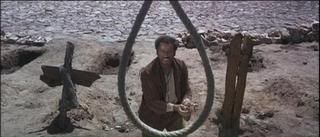
Year Released: 1966
Director: Sergio Leone
In the early 1960s, Sergio Leone had a desire to remake a classic Akira Kurosawa samurai film, Yojimbo. This wasn't the first time someone wanted to remake a Kurosawa film (The Magnificent Seven was a remake of The Seven Samurai). Luckily for Leone he had two things going for him: (1) Samurai films translate well into westerns and (2) The Magnificent Seven was a theatrical success. So, after A Fist Full of Dollars became the the first spaghetti western to receive a major international release, two sequels quickly followed.
Considered one of the greatest westerns ever made by critics and moviegoers alike, The Good, the Bad and the Ugly is the third and final film in Sergio Leone's "Man With No Name" trilogy. Clint Eastwood perfects the role this time, playing many of his scenes opposite Tuco (Eli Wallach) who refers to Eastwood's character as "Blondie." The film opens with Blondie rescuing Tuco from a hanging. Tuco, having several bounties on his head, makes a deal with Blondie to have him turned in, and right before he's hung, Blondie "releases" Tuco from the rope around his neck. They split the bounty afterwards, going from town to town doing the same thing. When their strained relationship begins to sour, Blondie leaves Tuco to his own devices alone in the desert.
Tuco escapes the desert and is hell bent of turning the tables on Blondie. Before Tuco can abandon Blondie in the desert, they come across a runaway stagecoach carrying dying as well as dead Confederate soldiers. The circumstances turn on Tuco when a dying soldier asks for drink of water in exchange for the location of buried gold located a cemetery. Before the soldier dies, he whispers in Blondie's ear which grave hides the gold.
Tuco spends the rest of the film helping Blondie recover from the tortuous desert and then traveling with him throughout the country in search of the cemetery. Along the way, the two cross paths with a cold-blooded killer named Angel Eyes (Lee Van Cleef), who has also learned of the buried gold. The final act ends with one of the most brilliantly filmed gunfight stand-offs in cinematic history.
My View: Leone created his greatest western here, even though he went on to shoot a few more after Eastwood declined additional offers. Eastwood had made a name for himself by the film's release (which was uncommon with most spaghetti westerns), and was able to ride the on coattails of it's success. With it's signature close-ups, original score and shady characters, the film encapsulated everything that most Hollywood produced westerns could not accomplish for the past two decades. It has since gone on to influence a whole new generation of filmmakers and it still inspires today.
Best Line:
Man With No Name: "You see, in this world there's two kinds of people, my friend: Those with loaded guns and those who dig. You dig."
1. SILVERADO

Year Released: 1985
Director: Lawrence Kasdan
It's hard to believe, but I still can't believe that this film was released in the 1980s. It was completely unconventional for it's time. What I find more amazing about this film is that after twenty-three years, it still holds up very well.
Silverado opens with a beautifully choreographed gunfight. Emmett (Scott Glenn), asleep in his tiny shack is visited by three men intent on killing him. Once Emmett disposes of the men, he heads out to locate his younger brother. Emmett comes across Paden (Kevin Kline), who seems to have been left for dead out in the desert. Emmett befriends Paden and they ride into the next town where they encounter Mal Johnson (Danny Glover) who's harassed in a saloon because of the color of his skin. After Mal is asked to leave town, Emmett then discovers that his brother Jake (Kevin Costner) is scheduled for a hanging the next morning. Jake claims self defense, but the sheriff replies, "the jury saw it differently." Emmett breaks his brother out of jail the next morning and along with Paden and Mal, they head to Silverado to see their sister before moving to California.
Once in Silverado, our four protagonists find themselves in their own predicaments. Emmett and Jake run into trouble with a wealthy rancher and land owner named McKendrick. Mal goes to visit his father, who's been pushed off of his land by McKendrick and Paden discovers that the men who left him for dead in the desert are the lawmen now running Silverado. The final act brings them together to help free the town of a ruthless landowner and the corrupt law who's conveniently on his payroll.
My View: Silverado, to me, embodies the perfect western film: A great story, an ensemble cast, gorgeous scenery, a roaringly-good film score, efficient editing, multi-layered yet moral protagonists all executed with brilliant direction. To quote my wife, "re-watching this film is like having old friends over to visit." That's exactly how I feel about this film and why it has become increasingly difficult to find a western that can knock it down from the number one slot.
Best Line:
Mal Johnson: "Now, I don't wanna kill you, and you don't wanna be dead."
Between the ages of twelve and sixteen, my father had introduced to me two movies that helped shape what I felt were then, as well are still today, the quintessential films of the western genre. Both are located in the number one and number two slots and have become a measuring standard of everything else I've seen since then.
As my palette matured, so did my opinion of westerns. I started to appreciate not only the “action western” but films that took place in the American West that contained multi-layered characters or films that were not only driven by action. I also started to recognize and admire films that were entirely different, or at least skewed from the mainstream of your sterotypical Hollywood western.
Here are my Top Ten Favorite Westerns:
10. THE OUTLAW JOSEY WALES

Year Released: 1976
Director: Clint Eastwood
By the time I first saw The Outlaw Josey Wales, I had already started down the road to my fascination with Clint Eastwood. But once I grabbed his biography off of a book store bargain rack, I was hooked.
In Outlaw, Clint Eastwood portrays the title character, Josey Wales, a farmer in Missouri who joins an outlaw confederate guerrilla unit after his family is slaughtered by the Union Army. Josey's main objective is vengeance; to hunt down those who destroyed his life. Throughout the film he comes in contact with quite an assortment of characters who end up joining him on his journey, with or without his consent. By the end, the pages turn, and he ends up being pursued by the group who incidentally killed his family in the first place, which leads to a rather satisfying climax.
My View: The Outlaw Josey Wales is one of Clint Eastwood's best directorial efforts. Unlike the "Man With No Name", Eastwood provides the audience with a great deal of sympathy for Josey, and in doing so, he makes the character much easier for everyone to identify with. The film is beautifully weaved with witty and humorous dialog, (not always a common factor in most of Eastwood's westerns), where Lone Waite, played brilliantly by Chief Dan George, steals almost every scene opposite Clint Eastwood.
Best Line:
Josey Wales: "When I get to likin' someone, they ain't around long."
Lone Watie: "I notice when you get to dislikin' someone they ain't around for long neither."
9. OPEN RANGE

Year Released: 2003
Director: Kevin Costner
At one point in time, Kevin Costner could do no wrong. Then, in 1995, Waterworld was released, and American moviegoers weren't sure if what they had been investing in for the past ten years was still paying off. Suddenly, Costner wasn't a guaranteed bankable blockbuster star, at least for the studios. Since then, his films have been hit-and-miss. Then along came Open Range.
Costner, while battling pneumonia and later a burst appendix throughout production, was still able to bring to the screen what most audiences felt was dead: Another Great American Western. The film takes place during a post-Civil War America, where the great frontier is quickly losing its majestic presence, while ranchers and entrepreneurs buy up as much land as they can get their hands on. Boss Spearman (Robert Duvall) and Charley Waite (Costner) portray two cattlemen who run into more trouble than what either desires, when they're bullied by a rancher and his "hired guns" who despise their "free grazing" philosophy.
My View: Costner successfully brings to life an American West that most viewers have never seen before: the potential evils of entrepreneurship and how the haunting past of a violent and bloody civil war effected certain individuals. The pacing is a bit slow, but it never takes away from the simple, yet complex story of redemption. Costner should also be credited for portraying one of the most realistic gun fights ever filmed.
Best Line:
Boss Spearman: "My friend and me got a hankerin' for Switzerland chocolate and a good smoke."
8. ONCE UPON A TIME IN THE WEST

Year Released: 1968
Director: Sergio Leone
There are certain films that get better the more times they're viewed. Once Upon A Time In The West not only can be catagorized as that, but it can honestly lead the pack. I don't normally recommend it to most moviegoers; at least not at first. It's extremely hard to comprehend its cinematic brilliance on its first viewing. Instead, you're probably drawn more to your watch, realizing how unbelievably slow this movie is!
Are there pacing issues throughout this film? Absolutely (or at least to the novice popcorn muncher). However, for the more seasoned film connoisseur, you will be utterly transfixed on Sergio Leone's ability to turn a blank canvas into a beautifully-framed piece of artwork with a film camera. The story is rather simple: a mysterious harmonica player (Charles Bronson) joins forces with a desperado (Jason Robards) to protect a widow and her land from a hired gun (Henry Fonda) working for the railroad.
My View: Most critics say that if Eastwood would have signed on to do one more film with Leone, Once Upon A Time In The West would have ended up becoming their best collaboration. I think I would have to agree. The film definately stands up on its own merits, but Bronson is no Eastwood. Henry Fonda, however, perfectly demonstrates his acting chops. Normally seen as an "every man's hero", Fonda plays Frank with so much ruthlessness, that it's almost impossible to comprehend this sociopathic killer.
Best Line:
Frank: "How can you trust a man who wears both a belt and suspenders? The man can't even trust his own pants."
7. BUTCH CASSIDY AND THE SUNDANCE KID

Year Released: 1969
Director: George Roy Hill
This was the western that introduced me to a much larger variation on not only what a western was, but what it also could be. Butch Cassidy and the Sundance Kid starred Paul Newman and Robert Redford as the two historical characters whose mis-adventures were just as evident as their accomplishments. After one too many train robberies, Butch and Sundance are pursued through what seems to be half the country. In a desperate attempt to escape their ever persistent posse, they jump off a cliff, eventually escaping to Bolivia. In Bolivia, they eventually succumb to their old habits, but with unfortunate consequences.
My View: The late sixties were plagued with other counterculture ultra-violent outlaw movies, like The Wild Bunch and Bonnie and Clyde. Butch Cassidy and the Sundance Kid brought and entirely new spin to more than one type of genre, by presenting the American public with a good-natured western where the film displayed slapstick humor, traditional western action and contemporary music all while poking fun at western film cliches.
Best Line:
Butch Cassidy: "What's the matter with you?"
Sundance Kid: "I can't swim."
Butch Cassidy: "Are you crazy? The fall will probably kill you."
6. DANCES WITH WOLVES

Year Released: 1990
Director: Kevin Costner
Dances With Wolves is probably the most non-traditional western on my list. Non-traditional in the sense compared to the stereotypical "black hat" wearing antagonist, "white hat" wearing protagonist Hollywood western. It was, however, the first time I had truly remember seeing a film where Native Americans were not portrayed as only blood-thirsty savages and killers.
Lieutenant John Dunbar (Kevin Costner), in an attempt to end his life rather than losing his leg, unintentionally causes a stagnent civil war battle to be won by the Union Army. In return for his valiant efforts, he's treated by his general's surgeon and awarded the position at any U.S. Army post in the country. Dunbar choses a post located on the unsettled western frontier. Unbeknownst to him, Fort Sedgwick has been abandoned by the Army. When he arrives, he encounters a deserted base who had recently been housed by apparent individuals who had gone mad. Dunbar, after a few months, comes in contact with a Native American tribe, The Sioux. He develops a wonderful relationship with the Sioux and eventually joins their tribe. He tells his entire story through the writing of his journal.
My View: Other than my atrocious summary of the four-hour movie (yes, the director's cut is that long), Dances With Wolves does not age with time. The themes presented throughout the picture are just as hard-hitting today as they were when the film was released eighteen years ago. It also goes to show you how much the film industry has changed over the that time span. This picture grossed over $180 million dollars, but it took over 50 weeks in order to do so. Can you imagine a pictures staying in the theater for almost a year straight? Not in this day and age.
Best Line:
[Dunbar has found an old skeleton on the prairie]
Timmons: "I'll bet someone back east is going, 'Now why don't he write?'"
5. LONESOME DOVE

Year Released: 1989
Director: Simon Wincer
The only western listed here that was not an actual theatrically released film. Lonesome Dove was a mini-series that broadcast on CBS in 1989. This series presented to me a very story-driven western with wonderful multi-layered characters. The series didn't thrive on moving from gun battle to gun battle, but rather from brilliantly written and executed dialog.
Agustus "Gus" McCrae (Robert Duvall) and Woodrow F. Call (Tommy Lee Jones) are two ex-Texas Rangers who run a cattle ranch in Texas near the border of Mexico. The two decide to run a heard of cattle up north to Montana after a brief encounter with a former comrade shows up while on the run from killing a Mayor in Arkansas. The four episodes are beautifully weaved between several second-string characters played by Danny Glover, Robert Urich, Diane Lane, Fredrick Forrest, Rick Schroder, D.B. Sweeney, Anjelica Houson, Chris Cooper and Steve Buscemi among many others.
My View: I've never really even placed this mini-series in the same category as other television dramas. The sheer talent in the cast alone elevates it further than most mini-series from thirty years agos, let alone today. The producers hit the mark so high with this series, that all other sequels that followed couldn't even come close to this masterpiece.
Best Line:
Woodrow Call: "Well what does it say in Latin?"
[Gus blusters some gibberish]
Woodrow Call: "For all you know it invites people to rob us."
Gus McCrae: "Well the first man comes along that can read Latin is welcome to rob us, far as I'm concerned. I'd like a chance t' shoot at a educated man once in my life."
4. UNFORGIVEN

Year Released: 1992
Director: Clint Eastwood
I remember the first time I saw this film. I was sixteen and went to the movies with my girlfriend and her family. I had never seen anything like it before, and to be completely honest, didn't really care for it. It was slow and boring (pacing has always been an issue with me, with most Eastwood-directed pictures). But most importantly, I didn't understand at that age the kind of film that I was watching. It wasn't like the other Clint Eastwood westerns that I had grown up watching. Once I was in college, I had approached the film from an entirely new perspective.
Clint Eastwood plays Will Munny, a retired gunslinger and murderer, who changed his ways when he got married. He settled down, started a family, worked the family farm and eventually became a widower. He's approached by The Schofield Kid, a young and very senseless gunfighter who's heard of Munny's reputation. The Kid presents Munny with an offer to split a bounty of $1000 on killing two men wanted for cutting up and beating a prostitute in Wyoming. He at first declines, telling the Kid that his killing days are over. After reconsidering the offer, he joins the Schofield Kid along with his former partner, Ned Logan (Morgan Freeman). The prostitutes reside in Big Whiskey, a town run by Sheriff Little Bill Daggett (Gene Hackman).
Little Bill, more than likely a former gunfighter, shows himself to be quite the corrupted lawman by the time Will Munny arrives into town. Munny, who's deathly ill by the time they arrive at Big Whiskey, is harassed by Little Bill and his deputies. Little Bill wants nothing to do with any hired guns who've come into town to collect on the bounty. The final act turns everything upside down in the town. Munny decides to exact justice on those who run the town once Little Bill crosses the line acting as Big Whiskey's own judge, jury and executioner.
My View: I never realized how a violent movie could be seen as an anti-violence film. But once I watched Unforgiven at an older age, I finally understood the point that this film was trying to convey. Violence can be glamorized and romanticized to the point where killers can be seen as heroes. By turning the tables on convention, it opens your eyes to the gruesome reality that most certainly does exist.
Best Line:
Little Bill Daggett: "Well, sir, you are a cowardly son of a bitch! You just shot an unarmed man!"
Will Munny: "Well, he should have armed himself if he's going to decorate his saloon with my friend."
3. TOMBSTONE

Year Released: 1993
Director: George P. Cosmatos
While I did enjoy the more historically accurate Costner/Kasdan production of Wyatt Earp, Tombstone had embodied the perfect Hollywood-stylized western of the modern era. Besides, of the two films that portrayed Wyatt Earp in the 1990s, Tombstone beat Wyatt Earp to the theaters by six months and actually turned a profit.
Tombstone tells the story of Wyatt Earp (Kurt Russell) and his brothers Virgil and Morgan (Sam Elliot and Bill Paxton), who move to Tombstone, Arizona in pursuit of wealth. Upon their arrival, Wyatt is approached and asked to consider taking up a position in law enforcement in the city of Tombstone. Wyatt declines, expressing that his family's interests are to make money.
Throughout the first two thirds of the film, Wyatt, his brothers and his close friend Doc Holliday, slowly but surely create conflict with "The Cowboys," a gang that runs the town. A gun fight at the OK Corral later ensues, causing even more drama. After attempts on his brother's lives as well as his own, Wyatt decides to exact justice by wiping the state clean of The Cowboys Gang.
My View: Outside of a few silly moments, including one involving Kurt Russell yelling "No!" in slow motion before killing Curley Bill, the film holds up relatively well being fifteen years old. Tombstone pops with testosterone-filled dialog that is still sometimes quoted by myself and my friends. It revitalized an almost dead genre when it hit the theaters in 1993, but there are only a handful of films since it's release that have the honor of calling themselves westerns.
Best Line:
Wyatt Earp: "You gonna do somethin'? Or are you just gonna stand there and bleed?"
2. THE GOOD, THE BAD AND THE UGLY

Year Released: 1966
Director: Sergio Leone
In the early 1960s, Sergio Leone had a desire to remake a classic Akira Kurosawa samurai film, Yojimbo. This wasn't the first time someone wanted to remake a Kurosawa film (The Magnificent Seven was a remake of The Seven Samurai). Luckily for Leone he had two things going for him: (1) Samurai films translate well into westerns and (2) The Magnificent Seven was a theatrical success. So, after A Fist Full of Dollars became the the first spaghetti western to receive a major international release, two sequels quickly followed.
Considered one of the greatest westerns ever made by critics and moviegoers alike, The Good, the Bad and the Ugly is the third and final film in Sergio Leone's "Man With No Name" trilogy. Clint Eastwood perfects the role this time, playing many of his scenes opposite Tuco (Eli Wallach) who refers to Eastwood's character as "Blondie." The film opens with Blondie rescuing Tuco from a hanging. Tuco, having several bounties on his head, makes a deal with Blondie to have him turned in, and right before he's hung, Blondie "releases" Tuco from the rope around his neck. They split the bounty afterwards, going from town to town doing the same thing. When their strained relationship begins to sour, Blondie leaves Tuco to his own devices alone in the desert.
Tuco escapes the desert and is hell bent of turning the tables on Blondie. Before Tuco can abandon Blondie in the desert, they come across a runaway stagecoach carrying dying as well as dead Confederate soldiers. The circumstances turn on Tuco when a dying soldier asks for drink of water in exchange for the location of buried gold located a cemetery. Before the soldier dies, he whispers in Blondie's ear which grave hides the gold.
Tuco spends the rest of the film helping Blondie recover from the tortuous desert and then traveling with him throughout the country in search of the cemetery. Along the way, the two cross paths with a cold-blooded killer named Angel Eyes (Lee Van Cleef), who has also learned of the buried gold. The final act ends with one of the most brilliantly filmed gunfight stand-offs in cinematic history.
My View: Leone created his greatest western here, even though he went on to shoot a few more after Eastwood declined additional offers. Eastwood had made a name for himself by the film's release (which was uncommon with most spaghetti westerns), and was able to ride the on coattails of it's success. With it's signature close-ups, original score and shady characters, the film encapsulated everything that most Hollywood produced westerns could not accomplish for the past two decades. It has since gone on to influence a whole new generation of filmmakers and it still inspires today.
Best Line:
Man With No Name: "You see, in this world there's two kinds of people, my friend: Those with loaded guns and those who dig. You dig."
1. SILVERADO

Year Released: 1985
Director: Lawrence Kasdan
It's hard to believe, but I still can't believe that this film was released in the 1980s. It was completely unconventional for it's time. What I find more amazing about this film is that after twenty-three years, it still holds up very well.
Silverado opens with a beautifully choreographed gunfight. Emmett (Scott Glenn), asleep in his tiny shack is visited by three men intent on killing him. Once Emmett disposes of the men, he heads out to locate his younger brother. Emmett comes across Paden (Kevin Kline), who seems to have been left for dead out in the desert. Emmett befriends Paden and they ride into the next town where they encounter Mal Johnson (Danny Glover) who's harassed in a saloon because of the color of his skin. After Mal is asked to leave town, Emmett then discovers that his brother Jake (Kevin Costner) is scheduled for a hanging the next morning. Jake claims self defense, but the sheriff replies, "the jury saw it differently." Emmett breaks his brother out of jail the next morning and along with Paden and Mal, they head to Silverado to see their sister before moving to California.
Once in Silverado, our four protagonists find themselves in their own predicaments. Emmett and Jake run into trouble with a wealthy rancher and land owner named McKendrick. Mal goes to visit his father, who's been pushed off of his land by McKendrick and Paden discovers that the men who left him for dead in the desert are the lawmen now running Silverado. The final act brings them together to help free the town of a ruthless landowner and the corrupt law who's conveniently on his payroll.
My View: Silverado, to me, embodies the perfect western film: A great story, an ensemble cast, gorgeous scenery, a roaringly-good film score, efficient editing, multi-layered yet moral protagonists all executed with brilliant direction. To quote my wife, "re-watching this film is like having old friends over to visit." That's exactly how I feel about this film and why it has become increasingly difficult to find a western that can knock it down from the number one slot.
Best Line:
Mal Johnson: "Now, I don't wanna kill you, and you don't wanna be dead."

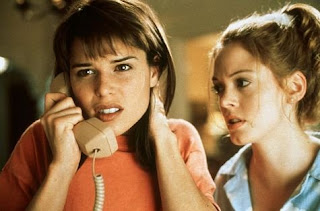
Comments
Post a Comment